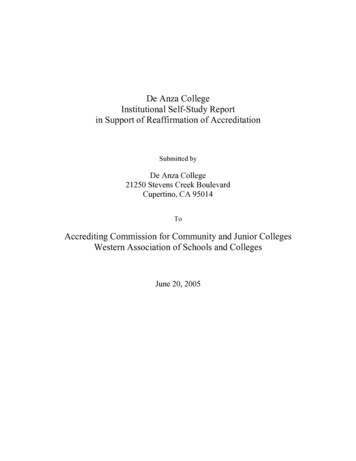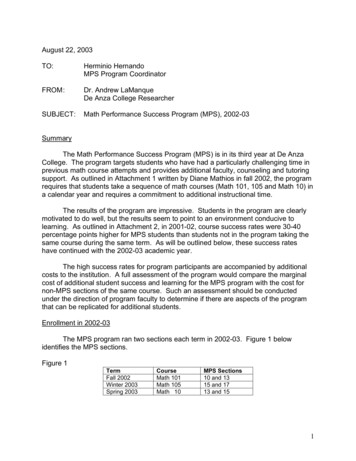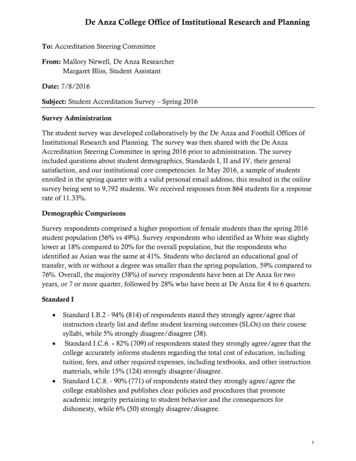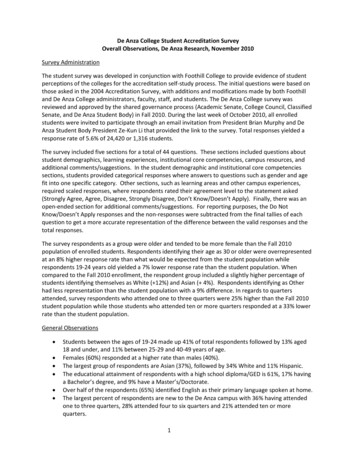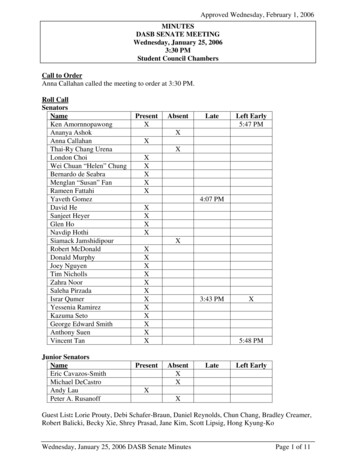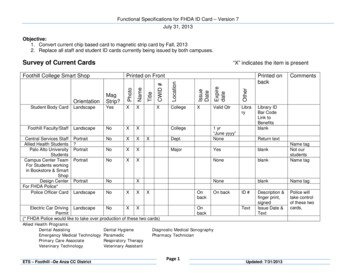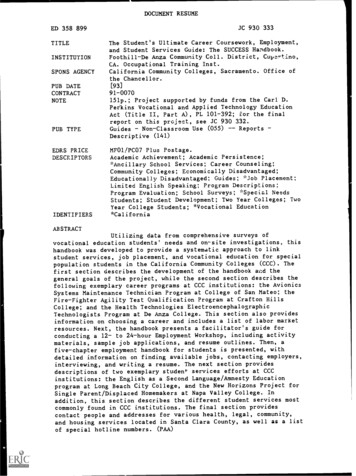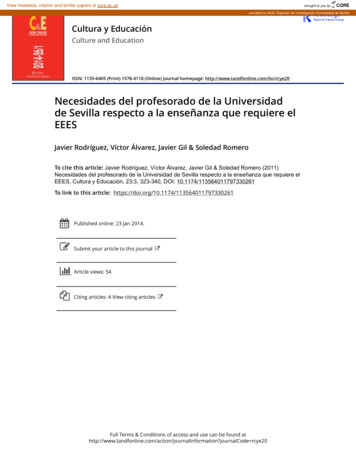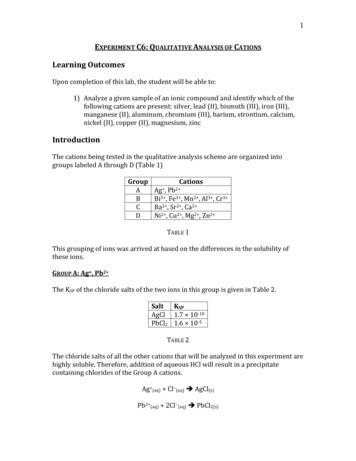
Transcription
1EXPERIMENT C6: QUALITATIVE ANALYSIS OF CATIONSLearning OutcomesUpon completion of this lab, the student will be able to:1) Analyze a given sample of an ionic compound and identify which of thefollowing cations are present: silver, lead (II), bismuth (III), iron (III),manganese (II), aluminum, chromium (III), barium, strontium, calcium,nickel (II), copper (II), magnesium, zincIntroductionThe cations being tested in the qualitative analysis scheme are organized intogroups labeled A through D (Table 1)GroupABCDCationsAg ,Pb2 Bi3 , Fe3 , Mn2 , Al3 , Cr3 Ba2 , Sr2 , Ca2 Ni2 , Cu2 , Mg2 , Zn2 TABLE 1This grouping of ions was arrived at based on the differences in the solubility ofthese ions.GROUP A: Ag , Pb2 The KSP of the chloride salts of the two ions in this group is given in Table 2.Salt KSPAgCl 1.7 10-10PbCl2 1.6 10-5TABLE 2The chloride salts of all the other cations that will be analyzed in this experiment arehighly soluble. Therefore, addition of aqueous HCl will result in a precipitatecontaining chlorides of the Group A cations.Ag (aq) Cl (aq) ! AgCl(s)Pb2 (aq) 2Cl (aq) ! PbCl2(s)
2The chlorides of all other cations will remain in solution. When this mixture iscentrifuged: the precipitate will contain the group A cations and the supernatantwill contain the cations from the other groups.Groups A, B, C, DAdd 6M HClPrecipitate: Group AAgCl, PbCl2Supernatant: GroupsB, C, DOf the two chloride precipitates, PbCl2 is soluble in hot water and AgCl is soluble inaqueous ammonia.Test for Pb2 When the chloride precipitates of the Group A cations are mixed with hot water,PbCl2 will dissolve. This is separated from AgCl by centrifuging the mixture. ThePbCl2 in the supernatant can be confirmed by reacting the supernatant with asolution of KI, which results in a yellow precipitate of PbI2.PbCl2(s) H2O(l) heat ! Pb2 (aq) 2Cl (aq)Pb2 (aq) 2KI(aq) ! PbI2(s) 2K (aq)Test for Ag The AgCl precipitate dissolves in aqueous ammonia due to the formation of acomplex ion.AgCl(s) 2NH3(aq) ! Ag(NH3)2(aq) Cl (aq)Addition of HNO3 results in the decomposition of the silver ammonium complex.The free silver ions combine with the chloride ions from the above reaction to formthe AgCl precipitate again.
3GROUP B: (Bi3 , Fe3 , Mn2 , Al3 , Cr3 )The hydroxides of the cations in this group are almost completely insoluble. The KSPof the hydroxide salts are given in Table 3.SaltMn(OH)2Fe(OH)3Bi(OH)3Al(OH)3Cr(OH)3KSP4.5 10-141.0 10-36Insoluble3.7 10-156.7 10-31TABLE 3The hydroxide salts of the Group C cations are far more soluble. Although, thehydroxide salts of the Group D cations are also quite insoluble, the distinctionbetween the hydroxide salts of Group B cations vs. Group D cations is that, thehydroxide salts of the Group D cations are soluble in aqueous ammonia, whereasthose of the Group B cations are not.Recall that the original mixture of cations was treated with HCl. This would not onlylower the pH but also result in the precipitation of the Group A cations as chlorides.After separating the Group A cations by centrifugation, the supernatant solutioncontaining all the rest of the cations should be treated with aqueous NH3. Thiswould raise the pH (i.e. increase the [OH ]) and precipitate the Group B cations. Thesupernatant containing the cations from Groups C and D can be obtained bycentrifugation.Of the five cations in this group, the hydroxides of Al3 and Cr3 are both soluble inan alkali. So, this group of cations is subdivided into two catagories: B1, whichcontains Mn2 , Fe3 , and Bi3 and B2, which contains Al3 and Cr3 .
4Groups B, C, DAdd aqueous NH3Precipitate: Group B- Mn(OH)2,Fe(OH)3, Bi(OH)3, Al(OH)3, Cr(OH)3Supernatant: Groups C, DAdd 6M NaOH 3% H2O2Precipitate: Mn4 *, Fe3 , Bi3 Supernatant: Al(OH)4-,CrO42-*NOTE: The Mn2 is oxidized to Mn4 by the H2O2The B1 cations are all soluble in HCl. The precipitate containing the B1 cations isdissolved in hot HCl solution. This solution is then tested for each of the three B1cations.Test for Mn2 In an acidic environment the Mn4 is reduced to Mn2 using H2O2. The Mn2 isconverted to MnO4 using bismuthate, BiO3 . The formation of a purple coloredsolution (from the MnO4 ) confirms the presence of Mn2 . The bismuthate is a strongoxidizing agent and causes a vigorous reaction and must therefore be added in smallportions.Mn4 (aq) H2O2(l) Mn2 (aq) O2(aq) H (aq)Mn2 (aq) H (aq) BiO3 (aq) Bi3 (aq) MnO4 (aq)Test for Bi3 (E RED 0.286 V) than Sn2 (E RED -0.136 V).Bi3 has a higher reduction potentialTherefore Sn2 reduces Bi3 . The reaction happens under basic conditions. Theformation of a black precipitate, which is the element Bi, confirms the presence ofBi3 .Bi3 (aq) Sn2 (aq) 7OH (aq) ! Bi(s) Sn(OH)72-(aq)
5Test for Fe3 Fe3 forms a complex with thiocyanate, SCN . Addition of potassium thiocyanate toFe3 produces a reddish-brown color due to the formation of this complex. Theformation of the reddish-brown color confirms the presence of Fe3 .Fe3 (aq) KSCN(aq) [FeSCN]2 (aq) K (aq)B2 cationsTreatment with 6 M NaOH and 3% H2O2 converts the B2 cations to Al(OH)4 andCrO42-. Under acidic conditions the following reactions occur.Al(OH)4 (aq) 4H (aq) ! Al3 (aq) 4H2O(l)2CrO42-(aq) 2H (aq) ! Cr2O72-(aq) H2O(l)Test for Al3 The solution containing the Al3 is treated with aqueous NH3. This results in theformation of a white aluminum hydroxide precipitate. The dye aluminon whenadded to the precipitate, changes the color of the precipitate. The appearance of ared color confirms the presence of Al3 .Al3 (aq) 3NH3(aq) 3H2O(l) ! Al(OH)3(s) 3NH4 (aq)Al(OH)3(s) aluminon dye ! red precipitateTest for Cr3 Any Cr3 present in the test solution is found as Cr2O72- at this point. In an acidicmedium the dichromate is oxdized by H2O2 to peroxychromate, CrO5. Theappearance of a dark blue colored CrO5 confirms the presence of Cr3 . However, theCrO5 is unstable and decomposes quickly. This causes the color to disappear.Cr2O72-(aq) 4H2O2(aq) 2H (aq) 2CrO5(aq) 5H2O(l)GROUP C: (Ba2 , Sr2 , Ca2 ) C and D is that they both form insolubleThe similarity between cations of Groupssalts with oxalate anion. However, the Group D oxalate salts are soluble in aqueousammonia whereas the Group C oxalate salts are insoluble in aqueous ammonia.Note that after separating the Group B cations, the solution is already in a mediumcontaining aqueous ammonia and at a high pH. Therefore, when ammonium oxalate
6is added to this mixture containing dissolved ions of Groups C and D, the Group Coxalate ions precipitate.Groups B C, DAdd aqueous NH3Precipitate:Group BMn(OH)2,Fe(OH)3, Bi(OH)3,Al(OH)3, Cr(OH)3Supernatant: Groups C, DAdd 6MNaOH 3%H2O2Add (NH4)2C2O4Precipitate: Mn4 *,Fe3 , Bi3 Supernatant:Al(OH)4-,CrO42-Precipitate: Group CBaC2O4, SrC2O4, CaC2O4Supernatant:Group DThe oxalate in the precipitate is removed by heating the precipitate with HNO3 in acrucible. The oxalate is converted to CO2(g). The precipitate is then dissolved in HCl.The three cations in this group will be analyzed by performing the flame test withthis solution. If the unknown mixture is known to contain more than one of Ba2 ,Sr2 , or Ca2 , then they must be separated first prior to conducting the flame test.Test for Ba2 , Sr2 , Ca2 A flame test is performed to analyze the presence of Ba2 , Sr2 , or Ca2 . A yellow-green light confirms the presence of Ba2 . A crimson color confirms the presence of Sr2 . A brick-red color confirms the presence of Ca2 GROUP D: (Ni2 , Cu2 , Zn2 , Mg2 )The supernatant solution following the removal of the Group C cations, contains theoxalate salts of the Group D cations that have been dissolved in aqueous ammonia.The oxalate as well as the ammonia will first be removed by heating the sample to
7dryness. Oxalates are removes as CO2 gas and ammonium ions are removed as N2Ogas. The residue at this stage is dissolved in HCl which results in a solution that maybe bluish green in color and will be used for analysis of the Group D cations.Test for Ni2 Under basic conditions, Ni2 forms a cherry rd color precipitate withdimethylglyoxime (DMG). The formation of the red color precipitate confirms thepresence of Ni2 .[Ni(H2O)6]2 (aq) 6NH3(aq) ! [Ni(NH3)6]2 (aq) 6H2O(l)[Ni(NH3)6]2 (aq) 2DMG ! Ni(DMG)2(s) 6NH3(aq)Test for Cu2 Under slightly acidic condition, Cu2 forms a maroon precipitate withhexacyanoferrate. The formation of the maroon precipitate confirms the presence ofCu2 .2[Cu(NH3)4]2 (aq) 4H (aq) [Fe(CN)6]4-(aq) ! Cu2[Fe(CN)6](s) 4NH4 (aq)Removal of Ni2 and Cu2 Sulfides of Ni2 and Cu2 are black insoluble solids. These precipitates arecentrifuged and removed prior to the analysis for Mg2 and Zn2 Test for Mg2 The test solution containing Mg2 and/or Zn2 is treated with aqueous NH3 andNa2HPO4. Zn2 , if present precipitates as Zn3(PO4)2 and Mg2 , if present precipitatesas MgNH4PO4.Mg2 (aq) NH4 (aq) HPO42-(aq) ! MgNH4PO4(s)3Zn2 (aq) 2NH3(aq) 2HPO42-(aq) ! Zn3(PO4)2(s) 2NH4 (aq)The precipitates are dissolved in NaOH; only the Zn3(PO4)2 dissolves. Presence of awhite precipitate after addition of NaOH confirms the presence of Mg2 .Zn3(PO4)2(s) 12OH (aq) ! 3Zn(OH)42-(aq) 2PO43-(aq)Test for Zn2
8The supernatant solution at the end of the last test is analyzed for the presence ofZn2 . Potassium hexacyanoferrate is added to a slightly acidic test solution.Formation of a white precipitate confirms the presence of Zn2 .2Zn(OH)42-(aq) 8H (aq) K4[Fe(CN)6](aq) ! Zn2Fe(CN)6(s) 4K (aq) 8H2O(l)
9Experimental DesignAn unknown solution containing SIX cations belonging to Groups A, B, C, and D willbe provided. The SIX cations must be identified using the procedures describedbelow.While testing the unknown sample, it is recommended to perform a test of knownsamples of ions within each group.The procedures described below use a set of standard protocols that will be usedduring various stages of the analyses. These standard protocols and the preparationof the known samples for each analysis are described in this section.1. Centrifuging the sampleCentrifuges will be used to separate a mixture into a solid precipitate and aliquid supernatant. The instructor will demonstrate the proper use of acentrifuge.The centrifuge tubes are provided in the “CHEM 1C Additional Kit” provided bythe stockroom. Only these tubes must be used inside the centrifuges. A tube ofapproximately the same mass in the opposite slot of the centrifuge must be usedto balance the centrifuge. Be sure that centrifuge tubes are neither cracked norchipped. The stress applied by the centrifuge can cause damaged tubes toshatter, resulting in chemicals and pieces of glass being scattered inside thecentrifuge. A centrifuge without a top is dangerous; always close the top. Do notslow centrifuges down with your hands. They are spinning at a high rate ofspeed, and if there is any imperfection on the spinning surface, it can catch theflesh and do a great deal of damage in only an instant.2. Separating a Precipitate from a SupernatantAfter centrifuging, a supernatant can be separated from a precipitate bydecanting. Carefully tip the centrifuge tube, and pour off the supernatant withoutdisturbing the pellet of solid. The supernatant may be poured directly.Alternatively, the supernatant can be removed by carefully suctioning it up into adropper.3. Washing the precipitateAfter separation from the supernatant, a precipitate is often washed to free itfrom reagents that might interfere at a later stage. Usually, the rinse is deionizedwater, but other liquids or solutions may be used. Add the indicated amount ofthe wash liquid and stir the contents of the test tube thoroughly. The pellet of
10solid must be broken up and mixed well with the wash liquid. After thoroughstirring, centrifuge the sample and decant the wash solution.4. Adjusting and testing the pHWhen directed to check the pH of a solution, stir the solution thoroughly with aclean glass stirring rod and then touch the tip of the rod to a piece of pH paper.Several such tests may be performed on each strip of paper. Never insert the testpaper into the test tube, since the chemicals on the paper could contaminate thecontents.5. HeatingDue to the small quantity of material being heated, test tubes containing samplesshould NEVER be heated directly in a flame. A solution in test tube can reach itsboiling point within a few seconds, and may be ejected violently from the testtube. All heating should be done using a water bath. Be careful that the tops ofthe test tubes are well above the water. The water may be boiling at times andcould spatter into the test tubes, contaminating the contents. Labeling tape willfall off in a boiling water bath; therefore, it is best to label test tubes that are tobe placed in a water bath with a sharpie marker.6. Performing a flame testWhen exposed to a flame, certain elements emit light of a characteristic color.Individual known sample solutions can be flame tested directly or the cation canbe precipitated and a flame test performed on the precipitate.In either case, a wire loop is used to introduce the sample into the flame. Theloop of the flame test wire must first be thoroughly cleaned of any tracecontamination. Begin by lighting a Bunsen Burner and adjusting the flame sothat it burns hot; that is it appears blue, not yellow. Insert the wire loop into thehottest part of a Bunsen Burner flame; the tip of the inner blue cone. If the wireis contaminated, the flame will exhibit a color characteristic of the contaminant.Repeat the process of dipping the wire loop into DI water and then into the hotflame until no contamination is evident. Note that upon sufficient heating thetest wire itself will turn the flame orange. After cleaning the wire, it can be usedto test a solution or a precipitate.To test a solution, use a clean dropper to remove one drop of the rest solutionand place this drop in the wire loop then insert it into the flame, observing thecolor that is emitted. For the known solutions, DO NOT insert the wire loopdirectly into the reagent bottle. Instead, place a small amount of the solution intoa test tube for use. Each metal cation may not emit at the same burnertemperature. Therefore, when performing flame tests best results are oftenobtained by slowly bringing the wire loop containing the sample into the flame
11from the side. As the wire moves into the flame, it is subjected to a range oftemperatures within the flame. This method of bringing the loop slowly into theflame is more important for the unknown samples, where concentrations of theemitting elements tend to be lower than in the known samples.To flame test a precipitate, centrifuge and decant the supernatant. Wet theprecipitate slightly with DI water. Dip a clean wire loop in the mixture containingthe sample. If solid is present, attempt to get some of it to stick to the loop. Insertthe wire loop into the flame, bringing the loop slowly into the flame from theside.7. Known sample preparation: Group ACombine 10 drops each of 0.1 M solutions of Ag and Pb2 in a centrifuge tube.Add three drops of 6 M HCl into the tube. Stir/shake the contents of the tube andwait for two minutes. Centrifuge the tube for two minutes. Discard thesupernatant and test the precipitate for the Group A cations.8. Known sample preparation: Group BObtain 10 drops each of 0.1 M solutions of Bi3 , Fe3 , Mn2 , Al3 , Cr3 in acentrifuge tube. Add four drops of 6 M HCl followed by 6 M NH3 until the pH ofthe solution is between 9 and 10. Centrifuge the tube for two minutes. Discardthe supernatant. Wash the precipitate twice with 10 drops of deionized water.Add 10 drops of 6 M NaOH and two drops of 3% H2O2 and place the mixture in aboiling hot water bath for two minutes. Centrifuge the mixture for two minutes.Analyze the precipitate for the B1 cations and the supernatant for the B2 cations.9. Known sample preparation: Group CObtain 10 drops each of 0.1 M solutions of Ba2 , Ca2 , Sr2 in a centrifuge tube.Add four drops of 6 M HCl followed by 6 M NH3 until the solution is neutral. Addan equal amount of NH3 in excess. Centrifuge the mixture for two minutes.Analyze the supernatant solution for the Group C cations.10. Known sample preparation: Group DObtain 10 drops each of 0.1 M solutions of Ni2 , Cu2 , Mg2 , Zn2 in a centrifugetube. Add four drops of 6 M HCl followed by 6 M NH3 until the solution is neutral.Add an equal amount of NH3 in excess. Add five drops of 0.5 M ammoniumoxalate. Stir the mixture and centrifuge for two minutes. Analyze thesupernatant solution for the Group D cations.
12Reagents and Supplies0.1 M solutions of Ag , Pb2, Bi3 , Fe3 , Mn2 , Al3 , Cr3 , Ba2 , Sr2 , Ca2 , Ni2 , Cu2 , Zn2 ,Mg2 Acids: 6 M HCl, 6 M HNO3, 6 M CH3COOHBases: 6 M NH3, 6 M NaOHOther reagents: 1 M KI, 3% H2O2, NaBiO3, SnCl2, 0.1 M KSCN, 1 M NaHCO3, 0.5 M(NH4)2C2O4, 3 M (NH4)2CO3, 0.1 M K2CrO4, 0.1% dimethylglyoxime, 0.1 M K4Fe(CN)6,Na2S2O3, 0.1 M Na2HPO4, 0.1% aluminon(See posted Material Safety Data Sheets)
13ProcedurePART 1: GROUP A (Ag , Pb2 )1. Obtain 10 drops of the unknown solution in a centrifuge tube.2. Add three drops of 6 M HCl into the above centrifuge tube.3. If a precipitate forms, then one of the group A cations in present in the unknown.In this case proceed to the next step. If no precipitate forms, then none of thegroup A cations are present and in this case proceed to Part 2.4. Centrifuge the mixture containing the precipitate for two minutes. Decant theprecipitate and save the supernatant for analysis in Part 2.5. Wash the precipitate with 10 drops of deionized water two times.6. Add 20 drops of deionized water to the precipitate and heat the mixture in aboiling hot water bath for three minutes.7. Centrifuge the mixture again. If there is no precipitate, then confirm the presenceof Pb2 using the test described in Step 8. If there is a precipitate, then confirmthe presence of Ag using the test described in Step 9.8. Test for Pb2 : Add three drops of 1 M KI to the clear solution from Step 7. Theformation of a yellow precipitate confirms the presence of Pb2 .9. Test for Ag : Add 10 drops of 6 M NH3 to the precipitate in Step 7. Stir themixture. If Ag is present, the precipitate will dissolve. Add 6 M HNO3 to the samesolution until a white precipitate of AgCl forms to confirm the presence of Ag .
14PART 2: GROUP B (Bi3 , Fe3 , Mn2 , Al3 , Cr3 )1. Obtain the supernatant from Step 3 of Part 1. If additional test sample is needed,then repeat Steps 1-3 of Part 1.2. Add 6 M NH3 to the above sample until the pH is between 9 and 10. Centrifugethe mixture for two minutes. The precipitate will contain the Group B cationsand the supernatant will contain the cations from Groups C & D. Save thesupernatant for analysis in Part 3.3. Wash the precipitate from Step 2 above twice with deionized water.4. Add 10 drops of 6 M NaOH and two drops of 3% H2O2 to the precipitate, mixthoroughly and place in a boiling hot water bath for two minutes.5. Centrifuge the above mixture for two minutes. The precipitate will contain thecations from Group B1 and the supernatant will contain the cations from GroupB2. Test for the B1 cations according to procedures described in Steps 6-10. Testfor the B2 cations according to procedures described in Steps 11-14.6. Test for B1 cations: Add 2 mL of deionized water to the precipitate from Step 5.Mix thoroughly and heat for 10 minutes in a boiling hot water bath. This willremove any excess H2O2 from Step 4. Centrifuge the mixture and discard thesupernatant.7. Test for B1 cations: Add 10 drops of 6 M HCl to the precipitate. Mix and heat for10 minutes in a boiling hot water bath. Centrifuge the mixture. The B1 cationswill be found in the supernatant. Use the supernatant in the next three steps totest for each of the B1 cations. Discard the precipitate.8. Test for Mn2 : To five drops of the supernatant solution from Step 7, add severalsmall amounts of NaBiO3 until no further reaction is observed. Centrifuge themixture and observe the color of the supernatant solution. A purple supernatantsolution confirms the presence of Mn2 .9. Test for Bi3 : To five drops of the supernatant solution from Step 7, add threedrops of 6 M NaOH followed by a small amount of SnCl2. Formation of a blackprecipitate confirms the presence of Bi3 .10. Test for Fe3 : To five drops of the supernatant from Step 7, add three drops of 0.1M KSCN. Formation of a reddish brown complex confirms the presence of Fe3 .11. Test for B2 cations: Obtain the supernatant solution from Step 5 above and heatthe solution for 10 minutes in a boiling hot water bath. Now, cool the solution ina cold bath. Add 6 M HCl until the solution is acidic and observe any color
15changes. Add 1 M NaHCO3 to neutralize the solution. Centrifuge the solution anddivide the supernatant into two parts to be used in Steps 12 and 13.12. Test for Al3 : To two drops of the supernatant from Step 11, add two drops of 6M HCl. Add two drops of aluminon followed by 6 M NH3 until the solution isbasic. Centrifuge the mixture for one minute. The appearance of a red precipitateconfirms the presence of Al3 .13. Test for Cr3 : To two drops of the supernatant from Step 11, add one drop of 3%H2O2. Now add 6 M HCl until the solution is acidic. The appearance of a dark bluecomplex confirms the presence of Cr3 . However, this complex decomposesquickly thereby causing the color to disappear.
16PART 3: GROUP C (Ba2 , Sr2 , Ca2 )1. Obtain the supernatant solution from Step 2 of Part 2. This contains the cationsfrom Groups C & D. If additional test solution is required, then repeat Step 2 ofpart 2.2. To the solution from Step 1 above, add five drops of 0.5 M ammonium oxalateand mix. The cations from Group C will precipitate and the cations from Group Dwill stay dissolved. Centrifuge this mixture for two minutes. Save thesupernatant solution for analysis in Part 4.3. Wash the precipitate with 1 mL of deionized water.4. Transfer the precipitate into a crucible. Use concentrated HNO3 to do thetransfer. Cover the crucible partially with a lid. Heat the crucible over a lowflame and evaporate the liquid.5. Cool the crucible for five minutes and add six drops of concentrated HNO3. Coverthe crucible partially with a lid. Heat the crucible over a low flame and evaporatethe liquid.6. Dissolve the precipitate in four drops of 6 M HCl. Transfer the solution to a cleantest tube.7. Test for Ba2 : Perform the flame test with the solution from Step 6. Emission ofyellow-green light confirms the presence of Ba2 .8. Test for Sr2 : Perform the flame test with the solution from Step 6. Emission of acrimson light confirms the presence of Sr2 .9. Test for Ca2 : Perform the flame test with the solution from Step 6. Emission of abrick-red light confirms the presence of Ca2 .
17PART 4: GROUP D (Ni2 , Cu2 , Zn2 , Mg2 )1. Obtain the supernatant solution from Step 2 of Part 3. This will contain theGroup D cations.2. Pour the supernatant liquid containing the Group D cations into a clean crucible.Place the lid on the crucible slightly ajar, and heat the solution to dryness over alow flame.3. Cool the crucible for five minutes, and then add six drops of concentrated nitricacid, washing the inside of the crucible. Replace the lid and heat to dryness onceagain.4. Cool the crucible for five minutes, repeat the addition of concentrated nitric acidand heat to dryness.5. Cool the crucible for 5 minutes, and dissolve the residue by adding 5-10 drops of6 M HCI. (It is alright if all of the solid does not dissolve.) Using a clean Pasteurpipet, transfer the solution to a clean test tube, label the test tube as “D”.6. Rinse the crucible with 5 drops of deionized water. Add this rinse to the test tubelabeled “D”.7. Test for Ni2 : Transfer one drop of the solution from test tube “D” to a clean testtube. Add 6 M NH3, with stirring, until the solution tests basic to litmus paper.Add one drop of 1% dimethylglyoxime. The appearance of a cherry redprecipitate confirms the presence of Ni2 .8. Test for Cu2 : Transfer one drop of the solution from test tube “D” to a clean testtube. Add 6 M NH3 until the solution tests only weakly acidic. If the solutionbecomes basic, use 6 M acetic acid to make it slightly acidic. Add 3-4 drops of 0.1M K4[Fe(CN)6], solution. The appearance of a maroon precipitate confirms thepresence of Cu2 .9. Separation of Cu2 /Ni2 from Mg2 /Zn2 : Add 6 M NH3 to the remainder of thesolution in test tube D until it tests slightly basic (pH 8-9). Then add 6 M aceticacid until the solution is weaklv acidic (pH 4-5). Add about 0.2 g of solid sodiumthiosulfate, Na2S2O3, and heat for five minutes in a boiling water bath. If Cu2 and/or Ni2 are present, then a black precipitate should form. If a blackprecipitate does not form under these conditions, add one to two more drops of6 M acetic acid and continue heating a few more minutes. (Formation of theblack precipitate is pH sensitive.) Cool for 1 minute by swirling the test tube incold tap water. Centrifuge and decant the supernatant into a clean test tubelabeled D1. The precipitate may be discarded.
1810. Test for Mg2 : To the solution labeled D1 add 6 M NH3 until the pH is about 8.Add 6-8 drops of saturated (about 0.1 M) Na2HPO4 solution. Stir and then coolthe solution in ice water for several minutes. If a precipitate does not form, add 6M HCl in drops to lower the pH slightly. Watch carefully for precipitateformation; stop adding the HCl upon formation of a precipitate. Centrifuge anddiscard the supernatant. The formation of a white precipitate indicates thepossibility of Mg2 .11. Wash the precipitate with 10 drops of deionized water. Discard the wash. To thewashed precipitate, add 6 drops of 6 M NaOH and stir thoroughly. Centrifuge anddecant the supernatant into a clean test tube labeled D2.12. Test for Zn2 : To the solution in the test tube labeled D2 add 6 M acetic acid untilthe solution tests only weakly acidic (pH 4-5). If the solution becomes too acidic,use 6 M NH3 to make it slightly acidic. Add 4 drops of 0.1 M K4[Fe(CN)6]. Theformation of a white precipitate confirms the presence of Zn2 .
19Data TableIn each instance, clearly describe the observations and the appropriate inferences.PART 1: GROUP A (Ag , Pb2 )CationAnalyzedPb2 Ag Observations fromknownObservations fromunknownInference aboutunknown
20PART 2: GROUP B (Bi3 , Fe3 , Mn2 , Al3 , Cr3 )CationAnalyzedBi3 Fe3 Mn2 Al3 Cr3 Observations fromknownObservations fromunknownInference aboutunknown
21PART 3: GROUP C (Ba2 , Sr2 , Ca2 , Co2 )CationAnalyzedBa2 Sr2 Ca2 Observations fromknownObservations fromunknownInference aboutunknown
22PART 4: GROUP D (Ni2 , Cu2 , Zn2 , Mg2 )CationAnalyzedNi2 Cu2 Zn2 Mg2 Observations fromknownObservations fromunknownInference aboutunknown
23ResultsSTUDENT NAME:UNKNOWN NUMBER:The unknown provided consists of the following SIX cations:Name123456Formula
following cations are present: silver, lead (II), bismuth (III), iron (III), manganese (II), aluminum, chromium (III), barium, strontium, calcium, nickel (II), copper (II), magnesium, zinc Introduction The cations being tested in the qualitative analysis scheme are organized into groups labeled A through D (Table 1) Group Cations A Ag, Pb2
